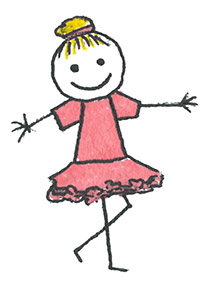Developmental Milestones
Birth to 5 Months
- Reacts to loud sounds
- Turns head toward a sound source
- Watches your face when you speak
- Vocalizes pleasure and displeasure (laughs, giggles, cries, or fusses)
- Makes noises when talked to
6 to 11 Months
- Understands “no”
- Babbles (says “ba-ba-ba” or “ma-ma-ma”)
- Tries to communicate by actions or gestures
- Tries to repeat your sounds
1 Year
- Recognizes his/her name
- Attends to a book or toy for about 2 minutes
- Follows simple directions accompanied by gestures
- Points to objects, pictures, and family members
- Uses “mama”, “dada” and other common nouns
- Tries to imitate simple words
1 ½ Years
- Enjoys being read to
- Follows simple commands without gestures
- Points to simple body parts such as “nose”
- Understands simple verbs such as “eat” “sleep"
- Uses 10 to 20 words consistently
- Asks for common foods by name
- Makes animal sounds such as “moo”
- Starting to combine words such as “more milk”
- Begins to use pronouns such as “mine”
- Uses words to communicate wants such as “more”, “up”
2 Years
- Articulation: correctly produces /m,n,p,b,t,w,h/
- Knows about 200 words
- Speaks in 2 to 3 word phrases
- Knows some special concepts such as “in”, “on”
- Knows pronouns such as “you”, “me”, “her”, “I”
- Knows descriptive words such as “big”, “small”
- Speech is becoming more accurate but may still leave off some ending sounds
- Strangers may not be able to understand much of what is said
- Answers simple questions
- Asks “what” and “where” questions
- Identifies body parts, animals, common household items
- Refers to self by name
- Stays with an activity for about 5 minutes
- Uses negatives such as “no”, “not”
- Begins to use plurals such as “shoes” or “socks” and regular past tense verbs such as “jumped”
2 ½ Years
- Knows about 450 words
- Tells first name when prompted
- Refers to self as “me” not by name
- Will say “watch me” to get attention of adult
- Uses some past tense, plurals, combines some nouns and verbs such as “baby eat”
- Uses short sentences such as “I do it"
- Holds up fingers to tell age
- Answers where questions
3 Years
- Strangers are able to understand much of what is said
- Can describe the use of objects such as “fork”, “car”, “bed”
- Recognizes language absurdities such as, “Is that an elephant on your head?”
- Expresses ideas and feelings rather than just talking about the world around him or her
- Identifies a few colors
- Groups objects such as food, clothes, etc.
- Knows night and day
- Begins to understand prepositional phrases such as “put the block under the chair”
- Tells a story
- Has sentence length of 3-4 words
- Asks “what” questions
4 Years (Preschool)
- Understands concepts such as “behind", “under”
- Understands complex questions
- Speech is understandable but makes mistakes pronouncing long, difficult or complex words
- Use some irregular past tense verbs such as “ran”, “fell”
- Lists items that belong in a category such as animals, vehicles, etc.
- Answers “why” questions
- Identifies basic shapes
- Asks “who” and “why” questions
- Stays with one activity for 10-12 minutes
- Understands “same” and “different”
- Can describe physical state (hungry, tired, etc.)
- Can complete analogies such as “my hand is big, your hand is ____”
- Uses qualitative concepts like short/long, big/small, wet/dry
5 Years (Kindergarten)
- Understands time sequences (what happened first, second, third, etc.)
- Carries out a series of three directions
- Understands rhyming
- Engages in conversation
- Sentences can be 5-6 words in length
- Describes objects and how to do things
- Uses imagination to create stories
- Knows common opposites
- Counts 10 or more objects
- Uses future, present and past tense verbs
- Shows interest in print
6 to 7 Years (Grades 1 and 2)
- Identifies most sounds phonetically
- Forms most sound letter associations
- Segments sounds in words
- Understands most time and space concepts
- Understands mathematical concepts such as “few”, “many”, “all,” “except”
- Follows oral directions in class
8 to 12 Years (Grades 3,4,5,6)
- Comprehends reading materials, including story problems
- Classifies words and identifies relationships such as “cause and effect”
- Can define words with a sentence
- Exchanges small talk with friends
- Initiates telephone calls and takes messages
- Begins to write effectively for a variety of purposes
- Understands verbal humor
